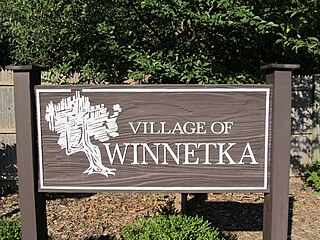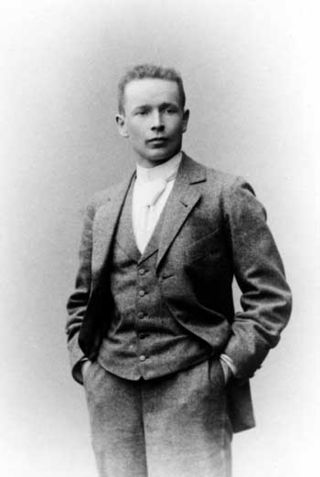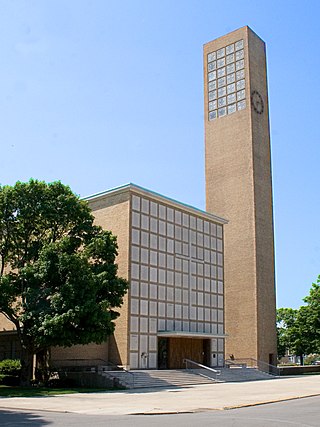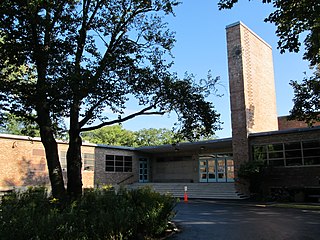
Eero Saarinen was a Finnish-American architect and industrial designer who created a wide array of innovative designs for buildings and monuments, including General Motors Technical Center in Warren, Michigan; the passenger terminal at Dulles International Airport outside Washington, D.C.; the TWA Flight Center at John F. Kennedy International Airport; and the Gateway Arch in St. Louis. He was the son of Finnish architect Eliel Saarinen.

Winnetka is a village in Cook County, Illinois, United States, located 16 miles (26 km) north of downtown Chicago. The population was 12,475 as of the 2020 census. The village is one of the wealthiest places in the United States in terms of household income. It was the second-ranked Illinois community on Bloomberg's 2019 Richest Places Annual Index.

The Cranbrook Educational Community is an education, research, and public museum complex in Bloomfield Hills, Michigan. This National Historic Landmark was founded in the early 20th century by newspaper mogul George Gough Booth. It consists of Cranbrook Schools, Cranbrook Academy of Art, Cranbrook Art Museum, Cranbrook Institute of Science, and Cranbrook House and Gardens. The founders also built Christ Church Cranbrook as a focal point in order to serve the educational complex. However, the church is a separate entity under the Episcopal Diocese of Michigan. The sprawling 319-acre (1,290,000 m2) campus began as a 174-acre (700,000 m2) farm, purchased in 1904. The organization takes its name from Cranbrook, England, the birthplace of the founder's father.

Gottlieb Eliel Saarinen was a Finnish-American architect known for his work with art nouveau buildings in the early years of the 20th century. He was also the father of famed architect Eero Saarinen.

The North Christian Church is a church in Columbus, Indiana. Founded in 1955, it is part of the Christian Church. The church building of 1964 was designed by Finnish-American architect Eero Saarinen (1910–1961) and completed in 1964. Saarinen's father Eliel Saarinen had designed the First Christian Church in Columbus.

The First Christian Church is a church in Columbus, Indiana, United States, built in 1942. It was the first contemporary building in Columbus and one of the first churches in the United States to be built in a contemporary architectural style.
Joseph Irwin Miller was an American industrialist, patron of modern architecture, and lay leader in the Christian ecumenical movement and civil rights. He was instrumental in the rise of the Cummins Corporation and in giving his home town international stature with its modern architecture buildings.

Prairie School is a late 19th and early 20th-century architectural style, most common in the Midwestern United States. The style is usually marked by horizontal lines, flat or hipped roofs with broad overhanging eaves, windows grouped in horizontal bands, integration with the landscape, solid construction, craftsmanship, and discipline in the use of ornament. Horizontal lines were thought to evoke and relate to the wide, flat, treeless expanses of America's native prairie landscape.

Florence Marguerite Knoll Bassett was an American architect, interior designer, furniture designer, and entrepreneur who has been credited with revolutionizing office design and bringing modernist design to office interiors. Knoll and her husband, Hans Knoll, built Knoll Associates into a leader in the fields of furniture and interior design. She worked to professionalize the field of interior design, fighting against gendered stereotypes of the decorator. She is known for her open office designs, populated with modernist furniture and organized rationally for the needs of office workers. Her modernist aesthetic was known for clean lines and clear geometries that were humanized with textures, organic shapes, and colour.

Harry Mohr Weese was an American architect who had an important role in 20th century modernism and historic preservation. His brother, Ben Weese, is also a renowned architect.

The A. Alfred Taubman College of Architecture and Urban Planning, also known as Taubman College, is the school of urban planning and one of the nineteen schools of the University of Michigan located in Ann Arbor, Michigan.

The GM Technical Center was inaugurated in 1956 as General Motors's primary design and engineering center, located in Warren, Michigan.

Christ Church Lutheran is a congregation of the Evangelical Lutheran Church in America (ELCA) in Minneapolis. Its buildings—a sanctuary with chapel (1949) and an education wing (1962) designed by Finnish-American architects Eliel Saarinen and Eero Saarinen—have been internationally recognized, most recently in 2009 as a National Historic Landmark by the U.S Department of the Interior.
Perkins&Will is a global design practice founded in 1935. As of 2022, Perkins&Will had 28 offices and over 2,500 employees. In the same year, Perkins&Will generated $572.47 million in earnings, making it the second largest architecture firm by revenue in the United States. Phil Harrison has been the firm's CEO since 2006.
Carleton Wolsey Washburne was an American educator and education reformer. He served as the superintendent of schools in Winnetka, Illinois, United States, from 1919 to 1943 and is most notably associated with the Winnetka Plan that he developed for his district.
Winnetka School District 36 is an elementary school district based in Winnetka, Cook County, Illinois, a suburb of Chicago that is due north of the city. The district is composed of five schools: three neighborhood elementary schools, and two middle schools. All schools are located within Winnetka boundaries.

The Charles J. and Ingrid V. (Frendberg) Koebel House is a private house located at 203 Cloverly Road in Grosse Pointe Farms. It was listed on the National Register of Historic Places in 2009.
Lilian Louisa Swann Saarinen was an American sculptor, artist, and writer. She was the first wife of Finnish-American architect and industrial designer Eero Saarinen, with whom she sometimes collaborated.

Eliel Saarinen's Tribune Tower design, also called the Saarinen tower, was an unbuilt design for a skyscraper by Finnish architect Eliel Saarinen. It was submitted in 1922 for the architectural competition organized by the Chicago Tribune for their new headquarters. The winning entry, the neo-Gothic Tribune Tower, was constructed in 1925. Saarinen's entry came in second place but had a significant influence on the design of numerous future buildings.

Philip Will Jr. (1906–1985) was an American architect in practice in Chicago from 1935 to 1980. He was cofounder of the global architectural firm Perkins & Will in 1935 and was president of the American Institute of Architects from 1960 to 1962.

















